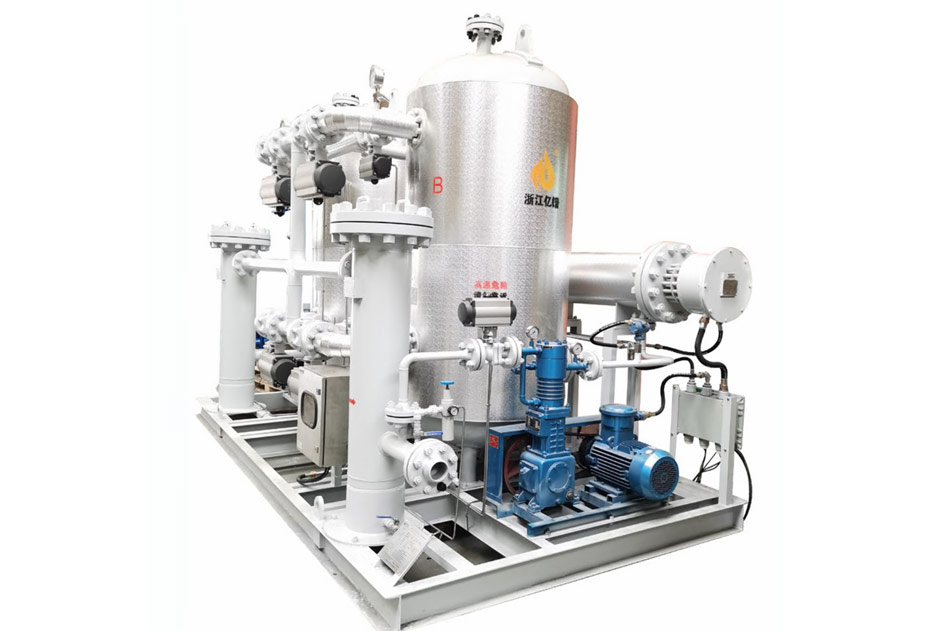Biogas Dehydration Solutions
Industry Pain Points
High Humidity Impairs Equipment Lifespan: Biogas has a high moisture content (usually saturated humidity, dew point ≥20℃), leading to issues such as corrosion of gas engines, water accumulation in pipelines, and valve jamming.
Low Energy Efficiency: Moisture reduces the calorific value of biogas—each 1% moisture lowers the calorific value by approximately 0.5%, affecting power generation or combustion efficiency.
Environmental Compliance Pressure: Combustion of moisture-containing biogas produces condensed acid (e.g., H₂SO₄), increasing the difficulty of exhaust gas treatment and making it hard to meet the Emission Standard for Air Pollutants (GB 16297).
High Operation & Maintenance (O&M) Costs: Traditional refrigeration dehydration consumes high energy, adsorbents require frequent replacement, and remote projects face difficulties in power supply.
System Overview
Yipu Biogas Dehydration Solution overcomes the challenges of purifying high-humidity, sulfur-containing biogas through a three-stage synergistic technology of “mechanical separation + condensation + adsorption”. Its value is reflected in:
- Long-term Stability: 5-year maintenance-free design, adaptable to harsh working conditions.
- Fast Investment Return: Project payback period of 1-2 years (calculated at an electricity price of 0.6 RMB/kWh).
- Green Compliance: Helps customers develop CCER carbon assets.
Solution Approach
Yipu Biogas Dehydration System Solution
| Module | Function |
|---|---|
| Pretreatment Unit | Removes H₂S and particles (activated carbon/biological desulfurization optional) |
| Condensation Dehydration Module | Plate heat exchanger + Freon refrigeration, rapidly reducing dew point to -5℃ |
| Adsorption Drying Tower | Dual towers operate alternately; service life of molecular sieves ≥5 years |
| VOCs Recovery | Recovers ≥85% of organic substances (e.g., CH₃OH) from condensate |
| Intelligent Electric Control Cabinet | Supports remote monitoring and links with the start/stop of generator sets |
| Zero-Discharge Design | Condensed water is reused after treatment; waste gas meets emission standards (non-methane total hydrocarbons ≤50mg/m³) |
Applicable Scenarios:
- Biogas power generation at landfills
- Agricultural biogas projects (livestock manure, straw)
- Biogas purification from anaerobic fermentation of industrial wastewater
Technical Principles
Three-Stage Dehydration Process:
- Mechanical Separation (First Stage):Cyclone separators remove liquid water droplets and particles (efficiency ≥90%).
- Condensation Dehumidification (Second Stage):Cryogenic heat exchangers cool biogas from 35℃ to 5-10℃, condensing free water (dew point reduced to -5℃).
- Adsorption Drying (Third Stage):Hydrophobic molecular sieves (3A-HP) deeply adsorb residual moisture, achieving a dew point of -40℃ (moisture ≤50mg/m³).
Intelligent Control:
The PLC automatically adjusts cooling capacity and adsorption cycles based on biogas flow and humidity, saving energy by over 20%.
Core Advantage
| Advantage | Details |
|---|---|
| Customized on Demand | Meets special working conditions; provides professional non-standard customization |
| Low Cost | Adopts cyclic regeneration process; significantly reduces operating costs |
| High Stability | Dual-tower structure with small pressure fluctuation; low noise and continuous gas supply |
| Fully Automatic Operation | Easy to operate, reducing labor input; improves efficiency |
| High Safety | Presets multi-level safety protection measures; supports automatic alarm |
| Low Failure Rate | Maintains low failure rate after 10,000 hours; high durability with almost no maintenance required |
Technical Strength
Leading Adsorption Dehydration Technology
Uses high-performance molecular sieve adsorbents with high water absorption capacity and resistance to corrosion by acidic gases (H₂S/CO₂), ensuring deep dehydration with a dew point ≤-70℃.
The original hot nitrogen regeneration process reduces energy consumption by 30% compared with traditional electric heating regeneration, and integrates a waste heat recovery system to significantly improve energy efficiency.
Modular and Customized Design Capability
Core equipment adopts modular prefabrication, supporting rapid deployment (installation cycle shortened by 50%) and adapting to diverse scenarios such as offshore platforms, onshore gas fields, and LNG pretreatment.
Can customize single-tower, dual-tower, or multi-tower parallel systems according to customer needs, with a treatment capacity ranging from 10,000 to 1,000,000 Nm³/d, flexibly matching gas fields of different scales.
Intelligent Control and Remote Operation & Maintenance
Equipped with a PLC+IoT intelligent control system, it real-time monitors key parameters such as pressure, temperature, and dew point, supporting fault early warning and automatic adjustment.
Through cloud-based big data analysis, it optimizes the adsorption-regeneration cycle, extends the service life of molecular sieves, and reduces O&M costs by 10%-15%.
Energy-Saving and Environmental Protection Technology
Features zero-emission design for regeneration exhaust gas, complying with international environmental standards such as EU CE and US EPA.
Energy consumption is 25%-40% lower than that of traditional triethylene glycol (TEG) dehydration systems, helping customers achieve carbon emission reduction goals.
Long-Cycle Operation Reliability
Molecular sieves adopt anti-pulverization coating technology, with a service life of over 5 years, reducing replacement frequency.
Key components (e.g., valves, instruments) are selected from international first-tier brands (e.g., Siemens, Emerson), with a Mean Time Between Failures (MTBF) of over 100,000 hours.
Strong R&D and Engineering Experience
Possesses more than 19 patents and software copyrights in dehydration technology; the R&D team is led by doctors and has in-depth cooperation with universities and colleges.
Has over 1,000 successful cases worldwide, covering extreme working conditions such as high-sulfur gas fields in the Middle East and low-temperature environments in the Arctic.
Product Advantage Comparison
| Indicator | Yipu System | Traditional Refrigeration Dehydration | Chemical Desiccant |
|---|---|---|---|
| Dew Point | -40℃ (customizable to -60℃) | -20℃ | -15℃ (requires frequent replacement) |
| Energy Consumption | 0.1kWh/m³ biogas | 0.25kWh/m³ biogas | No electricity consumption, but high chemical cost |
| Methane Loss | ≤0.5% | ≥2% (carry-over by condensation) | ≤1% |
| O&M Cost | <0.03 RMB/m³ biogas | 0.08 RMB/m³ biogas | 0.12 RMB/m³ biogas |
| Explosion-Proof Certification | Ex dⅡCT4 (full series) | Partially explosion-proof | Not applicable |
Typical Case
Project Name: A 10,000-Head Dairy Farm Biogas Power Generation Project
Treatment Capacity: 2000 m³/h of biogas (CH₄ content: 60%)
Dehydration Effect: Dew point reduced from +25℃ to -40℃
Economic Benefits:
- Power generation efficiency increased by 18%, with annual additional electricity revenue of 1.2 million RMB
- Condensed liquid recovered as raw materials for organic fertilizers, generating annual revenue of 300,000 RMBCarbon Emission Reduction: Reduces annual CO₂ equivalent emissions by 12,000 tons

